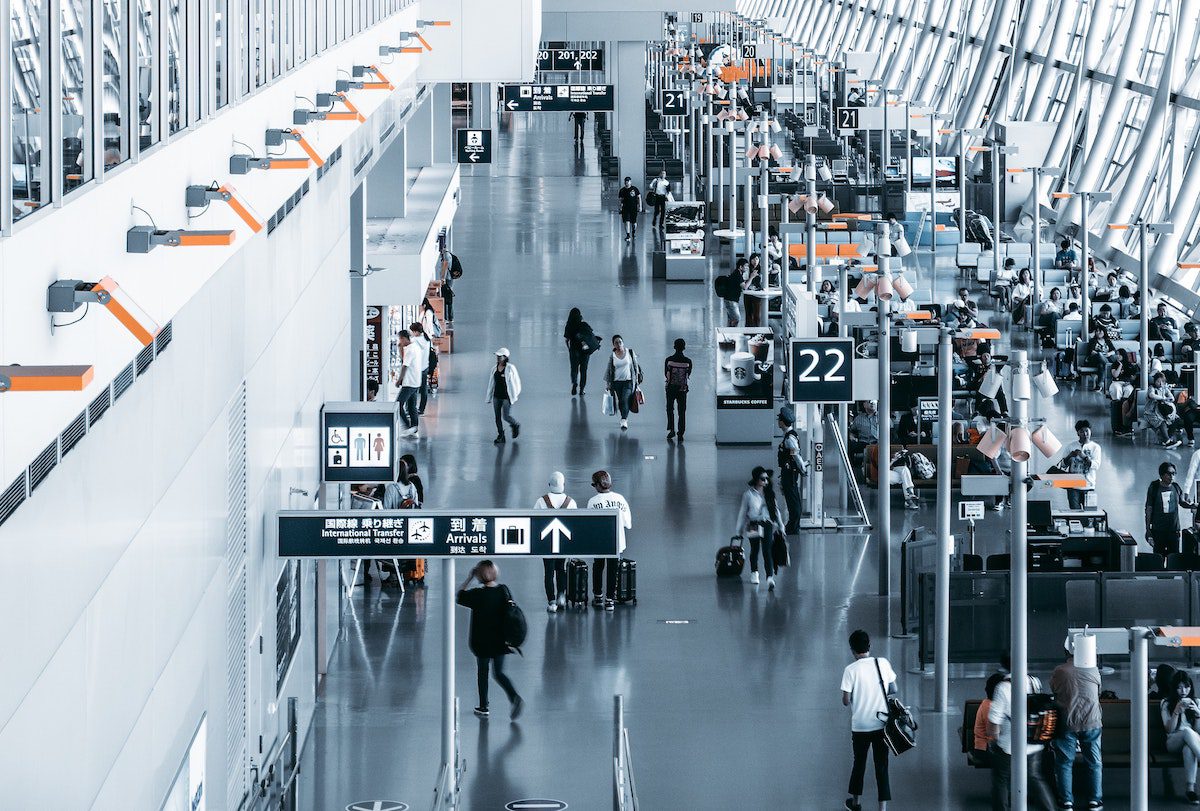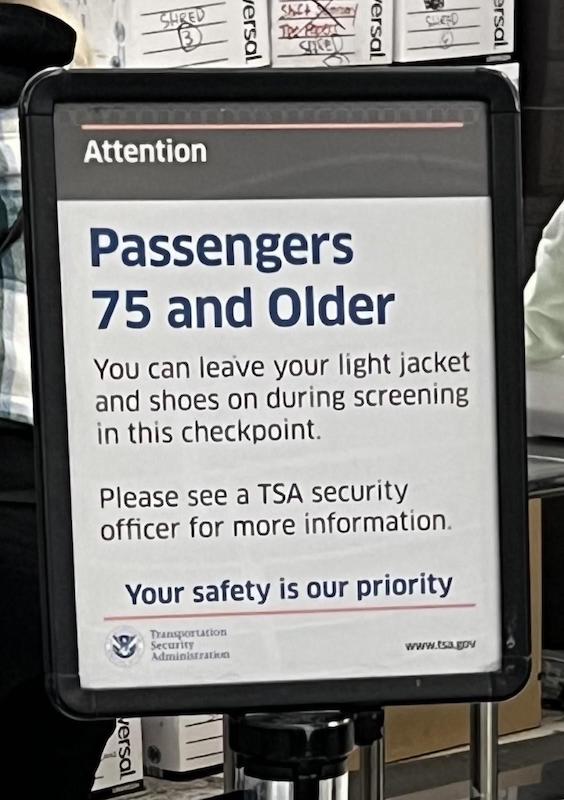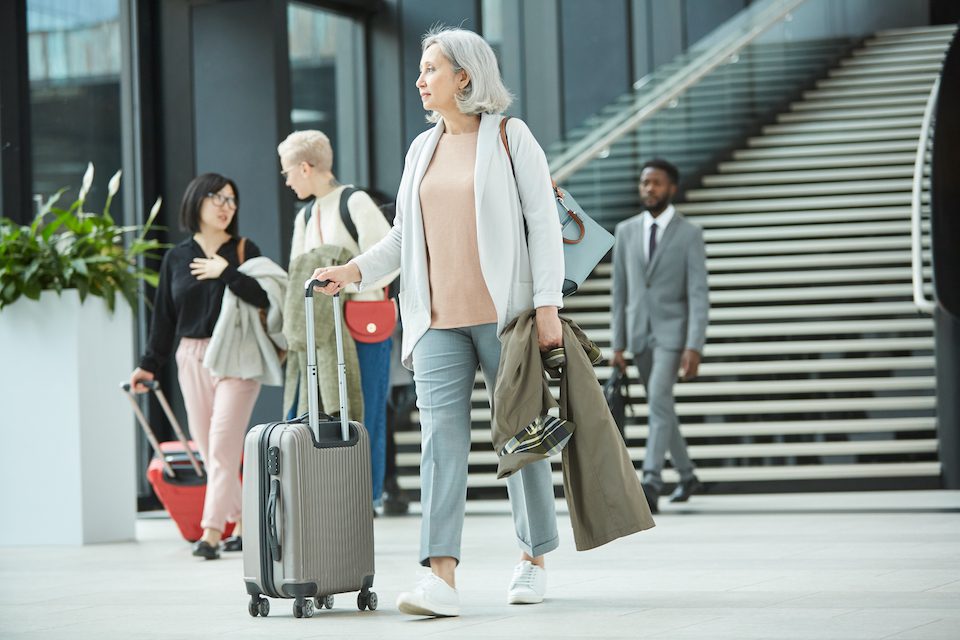Last updated on May 10th, 2024
Featured image: Travelers are advocating for more age-friendly airports to ease the burden of plane travel | Photo by AnnaStills on Envato
How to Get Through Airports and Still Have Enough Energy for Your Vacation
By Diana Eden, Contributor, Women Over 80 Travel
When I asked women on our private Facebook group ‘What do mature people hate about travel?’ most said that getting there and getting back is the most challenging part. In some instances, air travel has become so difficult that some women no longer want to travel to places where taking a plane is necessary. As airports get larger with multiple terminals and concourses, age-friendly airports are becoming less common, particularly for those of us with mobility challenges.
Five out of the 10 largest airports in the world are in the United States: Denver, Dallas, Orlando, Washington, and Houston. Denver covers 52 square miles. At my home airport in Las Vegas, it’s slightly more than 3/4 of a mile between the farthest point of the A gates to the farthest points of the C gates. At Chicago’s O’Hare International Airport, a passenger could travel about 1.04 miles by taking the long walk from Concourse C in Terminal 1, through the 745-foot underground pedestrian tunnel, past all the gates in Concourse B and back out to the end of the L Concourse in Terminal 3. (source: USA Today)
The airport experience needs to be more age-friendly
The airport and airplane experience needs much improvement and sensitivity to the aging population. For most travelers the experience ranges from uncomfortable to excruciating.
Lines form first at the check-in counters, especially during peak travel times. You inch along until finally you get called to a gate agent where you hoist your suitcase up onto the scale, and send it off to parts unknown, unless you have chosen to carry your luggage onboard, which creates its own stresses on the body.
Read More: What to Wear on the Plane for Women Over 80+
Then you approach the TSA security. Long snaking lines await you and once you finally get assigned to a checkpoint with its x-ray tunnel, you must remove shoes, belts, jackets, and jewelry, usually with nowhere to sit down to do so. Finally free to reassemble your outfit and gather all your belongings, a long walk is ahead. There might be a tram to another terminal, then another longer walk to your gate, which always seems to be at the farthest end of the concourse. And by now your rolling luggage and backpack are feeling heavier by the minute.
Upon landing, things can get worse. Often several jumbo airliners arrive from overseas simultaneously, and literally hundreds of people fill the arrival hall, lining up again to wait for the first available immigration agent. I have waited as long as two hours. And then to the baggage carousel to wait some more for your checked luggage, watching with hope eternal that it pops up the chute and heads to you before all the others.
And then to the taxi line.
Need I go on? Have I described anything that does not sound familiar?

Ways to make age-friendly airports a reality
We all know the FAA wants to keep us safe, and the airport managers want to keep us moving along. But has anyone given any attention to the large percentage of travelers between 50 and 90 and for whom this amount of physical activity is daunting?
Not all physical limitations are visible. Many travelers have had knee or hip replacements, or spinal fusions. Some have COPD and get winded from the effort of walking those distances amongst crowds. Many travelers are not physically limited to the extent that they need wheelchairs, though those that are are grateful for them.
In our most recent JourneyWoman “Limitless Accessibility” call, some of the suggestions to make airports more age-friendly from senior travelers were:
1. More seating, especially where there are long lines. A two-hour wait standing for check-in, TSA clearance, or immigration is just too hard on older people. Perhaps a seating area, with numbers called when you get near the front of the line?
2. A hold-my-place marker for bathroom breaks, especially for those traveling solo.
3. Special TSA lines for those with metal parts in their bodies.
4. Special lines just for ages 65 and over in all locations. In other words, senior lines.
5. Priority boarding for seniors at the gates. As of now, an announcement is made to allow early boarding for “Those who need a little extra time.” If this is you, take advantage of it!
6. More electric carts to move people quickly from point A to point B. The worst situation is short layovers! Airports need better-wheeled transportation to get people from gate to gate. It’s even worse if you have to change terminals.
Do airlines and airports realize that older travelers have plenty of available travel dollars to spend on flights, hotels, food, and tourism in general? We are willing to wait our turn in line, as long as the physical stamina required is understood and ways to mitigate the stress on our bodies are taken into consideration when designing airports. We do not want “special treatment”, we want considerate treatment, respectful treatment.
Join our next “Limitless Accessibility” Group Call on March 2, 2023. Register here.
Resources for wheelchair users
For those who need wheelchairs, there is actually a lot of information available.
The 1986 Air Carrier Access Act requires airlines to provide free wheelchair service to any traveler who asks for it, without requiring a description or documentation for that need. Make your requests for a wheelchair or electric cart when booking your flight. The policies are here: U.S. Department of Transportation and Canada Transport.
Most major airlines have website information under “Special Assistance” and phone numbers to call.
TripSavvy.com also links to information about Wheelchair Policies at the Top 10 U.S. Airlines and top 10 International Airlines.
WorldAirportGuides.com is a website that is a one-stop resource for airport information, airport hotels, airport parking, and information about Facilities for the Physically Challenged. Its directory has over 170 international airports. Look at airport maps and find out how far your gate is from the security checkpoint ahead of time. Be prepared.
Other tips to make airports more age-friendly:
- Talk to your travel agents about educating themselves about these needs and what facilities are available in the itineraries they are planning.
- Also talk to your tour companies. Tour companies must become more informed about challenges in transport, hotels, and local places of interest.
- Advocate to anyone who will listen for a national database for mobility-challenged travelers. Cities sometimes have them, so should airlines, airports, and tours. Write Pete Buttigieg, Department of Transportation, US. Write letters of complaint to the Airport Manager if you had a bad experience. (As one woman said with a grin “We are all children of the ’60s, we know how to protest!”)
- Wear slip-on shoes to get through the TSA checkpoint. Later you can switch to your more supportive lace-up shoes. (There is no seating to take OFF shoes, only to put them back on). And perhaps they could lower the “No Need to Take Off Shoes for Over 75” to age 60 and up? When was the last time a senior snuck a forbidden object through her orthotic Dr. Comforts?
- Look into getting a portable seating device that will pass security. Most folding chairs or canes with chairs are made of aluminum and will not get past security. This is the only one made of wood that I found.
- Board early, even if your handicap is not visible. To hell with comments and stares of others. They will understand eventually when it happens to them.
- Tip your wheelchair people well.

Airports should consider lowering this age to 60 / Photo by Diana Eden
Do you have more tips to share? We’d love to hear them below!
More to Read From the Older Adventuress
Is 85 Too Old to Travel Internationally? A Trip to Essaouira, Morocco Shows It’s Not
An injury at age 85 made me rethink travelling, but a trip to Essaouira, Morocco showed me I could return to travel with confidence.
When Something Goes Wrong: What to Do if You’re Injured While Travelling
Anything can happen on a vacation. Here are some first-hand tips for women to plan for an unexpected injury.
Catering to Solo Women of All Ages: A Q&A With Phyllis Stoller, Founder, Women’s Travel Group
Visionary leader Phyllis Stoller, founder of The Women’s Travel Group, shares how her itineraries can help women get started in solo travel.






Diana Eden’s article is very informative, well written and makes so much sense, if only half of the suggestions become reality it will help so many people not only seniors.
Although I do not physically need a wheelchair, I do have white hair and look older. To avoid long walks in unfamiliar airports and the possibility of missing a flight, I always pre-book wheelchair service on all flights. The attendants quickly deliver me to the correct terminal and boarding area, wheelchair passengers zip thru Customs more quickly, and I always give a tip. I also take a photo of my luggage so the attendant can easily retrieve it from the baggage transit area. Less stress, no fee except tip.
Diana, thank you for your comments. I especially like the idea of taking a photo of your luggage.
If you are US based, apply for TSA Precheck! You don’t have to take your shoes off and you can leave on your jacket, making getting through security much easier and faster.
Another suggestion is to arrange for fast track service for when you arrive in an airport that you know will be busy or have long lines. An agent will meet you either on the jetway or just off the plane and walk you through all the necessary lines. What would have been a 2+ hour ordeal arriving in Denpasar, Bali this past summer took me 30 minutes and included installation of a SIM card in my phone. Just Google “fast track service” with the name of the airport you’ll be arriving in.
My last tip is to exercise and get in shape to make it easier to travel as we move into old age. Lift weights and do a little cardio so you can boost that carry-on bag into the overhead bin when you need to or jog through the airport to catch a departing plane! Being healthy and fit will make EVERY aspect of your travel better.
Thank you, Ruth, for your comments. Your last tip is especially important to note for travelers of all ages.
I am hard of hearing and unless posted cant understand when my group is called I go on preboard
This is a great article and needs more attention! I just experienced all of these challenges on my trip to Budapest last week!. As a well traveled 73 year old, with a knee and ankle replacement I was anxious about my first big International trip this month post COVID. Even with pre-check, Gobal Entry and my premium economy seats getting upgraded to Business class, my air travel had several high anxiety moments and was very very stressful. Changing planes for my International flight into LHR and then on to VIE was almost a nightmare. Changing terminals, long walks, and too short connection time left me questioning if I had the stamina to continue tro omy gate. With no assistance or no direction; getting to my next gate was incredibly difficult and physically demanding. One of my flights got canceled, my bags were lost for 3 days upon arrival in Europe and again on my return to PHX . My river cruise was excellent – except the the elevator did not reach my cabin and steps are hard for me. I still had a wonderful time. ….even though it was rocky at best.
Here are my tips for easier travel:
Order meet and greet/or wheelchair service to get you where you need to go or VIP service
Get an airtag to put in your luggage so you know where your bags are
Make sure you have TSA-Precheck/Global Entry updated.
Fly premium economy or business class if at all possible.
Make sure your cell phone allows for ease of use in foreign countries. You bring along recharging items/esp. when there is 1 outlet and you have 2 devices to re-charge. You’ve downloaded any apps you will need to refer to abroad (airline, hotel, transfers, city guides etc. )
Check and double check with your tour company; hotel or cruise partner about stairs, getting on and off small boats, walking distances and any medical /health issues that might need to be re-accommodated. The time to bring this up is well before your travel.
Get CFAR (cancel for any reason insurance)
I have an invisible condition that started affecting my joints in my 30’s, I am now 68. I traveled for business and learned to adapt and research products that help. First, I bought a Walkstool that has an extended seat height of 22″ but folds down to about 3″ dia x 17″ and has a nylon case that can be carried over the shoulder and weighs very little. As standing and walking became more difficult, I acquired a TravelScoot scooter that weighs just 32 lbs., has an airline apporved battery and can be ridden all the way down the jetway to airplan door with your luggage underneath. Total independance. The Atto Scooter is newer introduction to the market with many of the same properties and can actually fold into a suitcase-like shap but weighs 65 lbs.
I use a Liberty Trike to tour towns and villages, country fairs, art festivals, and food markets. It has larger tires for use on grass and gravel, can be folded for transport on a plane (free of charge, if used for a mobility device.)
First remeber that you are in charge of your own future, research and seek solutions that will provide the best quality of life you can live. Second, stand up for yourself. People try to tell me that I cannot use my Liberty Trike in a store, for example, but I point out that ADA states that it is classified as an Other Powered Mobility Device and allowed whereever pedestrians are allowed. If further pushbach is given, I kindly remind then that ADA Law is under Civil Rights and denying access is like denying access to a race, creed or orientation. The rebuttle usually ends there.
Allthe best in finding your own best.